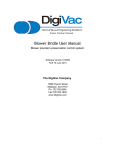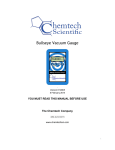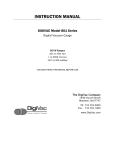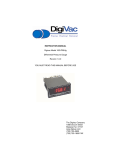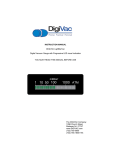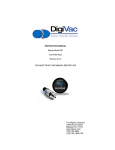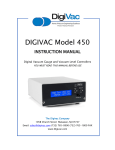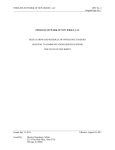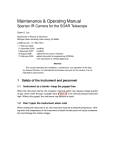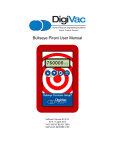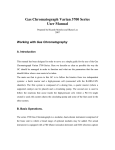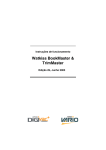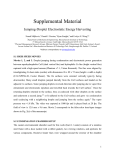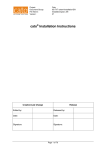Download Bullseye User Guide
Transcript
Bullseye Precision Vacuum Gauge Prototype Version K13J12 17 October 2013 The DigiVac Company 105B Church Street Matawan, NJ 07747 Ph: 732.765.0900 Fax:732.765.1800 www.DigiVac.com 1 Table of Contents Overview Quick Start for Lesker’s Field Analysis Vacuum Meter Modes of Display Display numeric Display Bar Display Pump-down Display time auto Menu of Configuration Options Display Numeric format Precision Standard Scientific Setpoint value Setpoint action Pumpdown time AutoOff time Sound Self Test Units Units pumpdown rate Calibration Version Auto Off Operation Set Point Operation Vacuum System Analysis Data set size Differential Analysis Reset Self Test Operation Field Calibration Calibration parameters Calibration functions Functions F/ATM and F/VAC Functions F/LOAD and F/STORE Calibrating the instrument UNDERSTANDING TORR 2 SERVICING AND MAINTENANCE GAUGE TUBE SERVICING Maintenance FACTORY REPAIR AND CALIBRATION NOTES ON CALIBRATION Instrument Accuracy SPECIFICATIONS 3 Overview The Bullseye precision Vacuum gauge was built to be a rugged, portable vacuum measurement instrument designed specifically for the demands of field use. First and foremost, it is a highly accurate vacuum gauge using field proven thermocouple vacuum sensor technology. The Bullseye precision gauge offers several viewing options including numeric, bar graph and pumpdown display. Portable ● Rugged design that offers a super-strong magnet for hands-free vacuum measurement ● Field proven thermocouple vacuum sensing technology Precise ● Bullseye accuracy available in 11 different measurement units ● Field calibratable Reliable ● 70 hour battery life ● Protective rubber boot ● Simple easy to use design Features: ● Auto Off ● On/Off soft switch ● Battery level indication ● Good/Bad tube indication ● 70 hour battery life ● Self test mode ● Field calibratable ● 3 different graphical displays of vacuum pressure ● Vacuum analytics for leak, outgassing and pump down 4 Quick Start for DigiVac’s Bullseye Precision Vacuum Gauge While this vacuum instrument has many features, it is very simple to use. Before anything else, it is an easy to use vacuum measuring device. First unpack the gauge to verify you’ve received everything you ordered. Next: 1. Remove protective boot. 2. Remove the battery cover and install 4 AA batteries 3. Plumb the thermocouple sensor into the system to be measured, taking care to keep the stem down 4. Power on the device by pressing the “PWR” button. It will take about 5 seconds to turn on. 5. If need be, turn on the backlight. The backlight does not affect gauge reading or accuracy 6. Read vacuum! Feel free to explore the latest copy of this manual at www.digivac.com for all the features that make this a truly useful tool. 5 6 Modes of Display The handheld gauge has four display modes: one numeric, and three graphs. The numeric display has three numeric formats: standard, precision, and scientific. Display modes are selected from the Configuration option “Display”, and numeric formats are selected from the Configuration option “Numeric”. The SEL button enters and traverses the Configuration menu. Display numeric The following example shows the numeric display with the “precision” format. The following image shows the numeric display with the “scientific” format. The numeric display shows the currently configured units, in these examples the vacuum pressure units are “microns” or “torr”. Below the units indicator are the battery, vacuum pressure, and vacuum system analysis indicators. In any display mode, the UP and DOWN buttons turn the backlight on and off (respectively), the SEL button enters the configuration menu, and the ENT button turns the gauge on or off. 7 In the previous example the battery indicator is shown at full strength and the vacuum pressure indicator is shown in its second of three (logarithmic / order of magnitude) levels. The following example shows the numeric display when the vacuum sensor tube is disconnected or has failed. Display Bar The bar graph visualizes the current sensor reading with a stepped bar. Display Pump-down The pump-down graph plots time horizontally and log pressure vertically. The horizontal time scale is selected using the configuration option “Pumpdown time”. The vertical pressure scale is logarithmic, indicating order of magnitude from one micron to atmosphere. 8 In the top left is the current vacuum pressure display figure. In the center of the first line is the Vacuum System Analysis, “PUMP”, and to the right is one of either the pump down rate in units per minute, or the data set window size in hours, minutes and seconds. The “STABLE” case shows data set window size (for example “1m18s”). Display time auto The auto-scaling (or, auto-ranging) time graph is a microscope into the pump down data. In this mode, the pump down graph is shown with a linear pressure scale that is fit to the pressure range of the data set. The height of the graph display is the pressure range of the data set in a linear scale (not log). The top left figure is the maximum value in this range, and the bottom left figure is the minimum value in this range. The top right figure is the current or most recent value in the instrument. Sometimes this visualization is not useful, showing noise. This noise comes from the from the instrument’s process of measurement, as well as the vacuum system under measurement. The auto scaling graph is a data visualization microscope, in this sense. Oftentimes this visualization is interesting in showing a very small climbing or descending trend that the Vacuum Analysis algorithm has not declared as a leak or pump. 9 Menu of Configuration Options Display Pressing the SEL button from the vacuum display screen will present the configuration menu. The configuration menu is a linear series of menu screens that are stepped or skipped through using the SEL button. Above each button is a utility hint to indicate button functions. The SKIP hint is above the SEL button to indicate that the SEL button is used to step or skip to the next menu screen with no configuration change. The ENTER hint above the ENT button indicates that this button is used to enter the display mode as shown in the menu screen. Using the UP or DOWN buttons will change the option available on the menu screen. In the example above, the configuration menu is ready to change the display to the Pumpdown Graph. In this state pressing the ENTER button will change the display to the Pumpdown Graph, or pressing the SKIP button will ignore the state of the menu screen and leave the display mode unchanged. Numeric format The numeric configuration option defines the vacuum pressure number format throughout all modes of display. The UP and DOWN buttons select a format type from “precision”, “scientific” and “standard”, and the ENT button saves the current choice. 10 Precision The precision format has three digits precision and micron accuracy. For example, an internal vacuum value of 1234 microns (µm Hg) would be displayed as 1.23 torr in the Precision numeric format with torr units. Standard The standard format has two digits precision and micron accuracy. For example, an internal vacuum value of 1234 microns (µm Hg) would be displayed as 1.2 torr in the Standard numeric format with torr units. Scientific The scientific format has two digits precision with a base ten exponent following conventional usage. For example, an internal vacuum value of 1234 microns (µm Hg) would be displayed as 1.2 x 100 torr. Setpoint value The Set Point Value is defined in terms of the current vacuum pressure units. The Set Point indicates a pump down to configured pressure state according to the configuration of the Set Point Action. See “Set Point Operation” for more detail. Setpoint action The Set Point Action is defined as one of a set of choices, including: None, Beep, Beep and Flash, or Flash. For details of operation, refer to the section “Set Point Operation”. Pumpdown time The pumpdown time configuration option defines the width of the Pumpdown Graph and pumpdown rate window. 11 The pumpdown rate is the difference between the start and end of the pressure data shown in the pumpdown graph. For example using a pumpdown time of ten minutes, a system pumpdown from atmospheric pressure to one torr in ten minutes has a pump down rate of 760 torr per ten minutes or 76 torr per minute. AutoOff time Use this configuration option to save battery power during periods of inactivity. The figure zero will disable the auto off battery saver feature. To see the specifics of this feature, look at the Auto Off Operation section. With a positive (non zero) value, the unit will indicate the Auto Off Sound The two sound configurations determine the audible Set Point Alarm and Calibration Storage Acknowledgement tones, named “Sound SP” and “Sound Cal” respectively. The Set Point Alarm sound is typically configured to a different value from the Calibration Acknowledgement sound. Self Test The self test function reviews the Tube and Battery status, and resets the internal Elapsed Time Clock, Pump Down Data, and Auto Off subsystems. Enter the Self Test sequence with this option. Refer to the section “Self Test Operation” for more detail. 12 Units The units configuration option permits numeric vacuum values to be displayed in any one of a 11 available vacuum pressure units including microns, millitorr, millimeters of mercury, Torr, mbar, Bar, Pa, kPa, inches of mercury, inches of water and PSIA. Note that inches of mercury and inches of water is zero referenced to 760 Torr absolute pressure. A negative number indicates vacuum, a positive number indicates pressure relative to sea level. Units pumpdown rate The units pumpdown configuration option permits the pumpdown rate figure displayed in the Pumpdown Graph to employ identical or different units from the numeric vacuum units. Use this option to change the pumpdown rate units. This option has been included to support work with multiple sources of technical documentation for the vacuum system, and vacuum system pump down. The “Sync” option, shown in this example (above), maintains the pumpdown rate units as identical to the primary vacuum units. Of course this is the recommended configuration, as employing mixed units could be a source of misunderstanding. Calibration This configuration option may enter the field calibration mode. Refer to the section “Field Calibration” for a complete description of the operation of the Calibration function. Version The last step in the configuration menu reports the software version identifier. 13 This software version identifier is useful for communicating with the factory or distributor support. Auto Off Operation The auto off feature has been defined as an unattended mode of operation to not conflict with other unattended modes of operation. The Handheld Gauge will not turn itself off when: ● connected to a system under vacuum (less than 100 Torr, pump down feature set); ● initially filling the pump down data set (pump down feature set); ● not timed-out since pump down or button activity; ● in calibration mode. Set Point Operation A Set Point may be defined to beep (configured sound) or flash (invert display) when a low pressure vacuum has been achieved. The Set Point Value is defined with the Configuration option “Set point V units” for V between one micron and atmosphere. The Set Point Action is defined with the Configuration option “Set point A” for A one of “None”, “Beep”, “Flash”, “Beep&Flash”. The Set Point Alarm is raised on successfully achieving the objective vacuum pressure (Set Point Value). The Set Point Alarm is lowered, but not cleared, on pressing any button while the alarm is raised (display flashing or beep sounding). The Set Point Alarm is cleared, and is ready to be raised again, when the pressure in the system under test rises well above the Set Point Value. Vacuum System Analysis The result of the Vacuum System Analysis is one of “PUMP”, “LEAK”, “OUTGAS” or “STABLE” and is shown in some display modes. Internally, one data set serves the Pump down and Time Auto graphs as well as the Vacuum System Analysis. The data is visualized in the Pump down and Time Auto graphs. The data set is maintained continuously in every mode of operation. Data set size 14 The width of the data set in time is configured with the option “Pumpdown time”. This figure is employed to determine the time slices that are accumulated at a rate of roughly three updates per second. A small difference will accrue to the actual data set span in hours, minutes, and seconds. The Pump down graph with a “STABLE” case (under 100 torr) will display the actual time window size in hours, minutes and seconds. Differential Analysis The Vacuum System Analysis looks at the last quarter of the pump down data set to determine the state of the system under test. The whole analysis is recomputed approximately three times per second. The “LEAK” result indicates pressure increasing towards atmosphere with rates that are not typically indicative of outgassing alone. The “PUMP” result indicates a strong pressure descent to vacuum as for a system under vacuum pump down. The “OUTGAS” result indicates evidence of outgassing. Evidence of outgassing is a pressure trend that is ascending at a rate that is decreasing. Eventually the rate of ascent decreases until the pressure stabilizes. The “STABLE” result indicates no particular evidence of venting (LEAK) or outgassing, and is shown for slow pump down rates for the benefit of the experience of working with the instrument. The “STABLE” case partially obscures some (weak) “PUMP” cases in order to stabilize the instrument display. Reset The pump down data set is cleared in power-off states: turned off, or dead or missing batteries. 15 Self Test Operation The Self Test feature is available from the Configuration option “Self Test”, pictured below. From this Configuration option, press the ENT button to enter the Self Test sequence. The Self Test sequence proceeds on any button press through a set of steps. The first step in the Self Test sequence, shown below, performs tests of the Battery level and Tube connection. Pressing any button will increment the Self Test sequence to the second step, shown below. The second step reviews the detailed results of the tests performed in the preceding step. Pressing any button will proceed to the third step. The third step reports the overall condition as GOOD or NOT GOOD, based on the results reviewed in the previous step. Pressing any button will exit the Self Test and reset the Elapsed Time Clock and dependent subsystems including the Pump Down Data Set -- as occurs on any power off state (turned off or batteries dead or missing). 16 Field Calibration From the Configuration option “Calibration”, pictured below, press the ENT button to enter the field calibration mode. The field calibration mode, shown below, shows digital signal counts and torr pressure times 10,000 (“Torr x 10+4”). For example, one micron (or millitorr) is “10” in the “Torr x 10+4” scale. Calibration parameters The calibration method employs a “zero and span” model. The “ATM” parameter is modified to align to 300 torr, and the “VAC” parameter is modified to align to 5 millitorr. In the “Torr x 10+4” scale employed in the Calibration mode, these pressures are represented with the figures 3000000 and 50, respectively. Calibration functions The Calibration mode operates using a function concept. The current function is one of four available functions (operations) and is shown above the EXIT button hint as “F/LOAD” in this example. The four functions are F/LOAD, F/STORE, F/ATM, and F/VAC. The SEL button changes the current function among these four possibilities. Functions F/ATM and F/VAC The F/ATM and F/VAC functions enable the UP and DOWN buttons to change these parameter values. As these parameter values change, the internal pressure value register shown in the Calibration display (at “Torr x 10+4”) is modified. These values are not saved for use beyond the calibration session until they are stored using F/STORE. Functions F/LOAD and F/STORE The F/LOAD and F/STORE functions read and write parameters from and to persistent memory (long term storage). One of these two functions is available when the function indicator above the EXIT hint shows F/LOAD or F/STORE. In this case, pressing and releasing the UP and DOWN buttons together will execute the function. When the function has been successfully executed the display will flash, and an audible beep will sound (with the tone configured in “Sound Cal”). Completing a calibration session requires execution of F/STORE in order to save the parameters to persistent memory before exiting the calibration session. Exiting a calibration 17 session without successfully executing the F/STORE function will discard the calibration parameters. Calibrating the instrument 1) Set Cal points VAC, MID and ATM to zero 2) Get counts to 105600 +/-500 (105100 to 106100) and adjust "MID" so Bullseye Vac Reading reflects standard. I found that the actual vacuum value at this counts is somewhere between 2 and 270 Torr. (Note step 2 needs to be done on each gauge individually) 3) Set manifold vacuum to 760 Torr, and adjust "ATM" so Bullseye reading reflects Standard +/- 10 Torr 4) Set manifold vacuum to .005 Torr, and adjust "VAC" so Bullseye reading reflects standard +/- 0.001 Torr 5) Store 6) Check ATM is +/- 20 Torr 7) Check Vac is +/- 0.002 Torr UNDERSTANDING TORR The DIGIVAC and many similar instruments are calibrated in microns or "milliTorr." It is appropriate to discuss what microns are and to relate microns to other measures of pressure and vacuum. Microns are not really a measure of vacuum at all, but rather of absolute pressure. It will be recalled that the pressure of the atmosphere is 14.696 or approximately 14.7 pounds per square inch at sea level. This pressure is due to the weight of all of the air in the earth's atmosphere above any particular square inch. This 14.696 psi is equivalent to the pressure produced by a mercury column of approximately 29.92 inches high or .76 meters (about 3/4 of a yard) or 760 millimeters of mercury. Atmospheric pressure varies greatly with altitude. It decreases approximately 1 inch of mercury per thousand feet of altitude. It also varies widely with local weather conditions. (Variations of one half inch in a single day are common.) The word vacuum means pressure lower than atmospheric or "suction," but, in describing negative pressure, the atmosphere is only a satisfactory reference if we are dealing with values of vacuum down to about 27 inches of mercury. Below that, it is much more useful to talk in terms of absolute pressure, starting from absolute zero. The 801 and all similar instruments do just this. One TORR, a commonly used unit, is an absolute pressure of one millimeter of mercury. A milliTorr is equal to one thousandth of a TORR. A MICRON is the same as a milliTorr. 18 SERVICING AND MAINTENANCE GAUGE TUBE SERVICING In many cases, a gauge tube may become fouled with oil or other foreign matter. It is often possible to restore the functionality of contaminated probes with cleaning. If the contaminant is known, the tube should be filled with a fluid that is known to be a solvent to that contaminant. As an example, ether is often effective in removing residues of some oils. Commercial carburetor cleaners are very powerful solvents and are highly effective against some contaminants. After cleaning with solvents, the gauge tube should be completely dried or flushed with a volatile solvent to assure that it is dry prior to re-installing it. If this is not done, contamination of the system may result. Maintenance Your vacuum instrument should give you many years of trouble free service. There are no regularly scheduled maintenance intervals. If consistent accuracy is required, it is recommended that the gauge, tube, cable and power supply be returned for a yearly calibration check. FACTORY REPAIR AND CALIBRATION The vacuum gauge assembly is designed to provide years of trouble-free service, and the liberal internal use of plug-in components make it easily repairable. No field servicing of the unit is recommended, other than replacement of the gauge tube, but factory servicing and calibration are available at a nominal cost and fast turn-around times. NOTES ON CALIBRATION The instrument is calibrated in nitrogen, which has thermal properties virtually identical to air. Other gasses will affect the readings by an amount proportional to the thermal conductivity of the gases. In most cases, the gases present in a vacuum system will be air, nitrogen, or oxygen, and no appreciable errors will occur. Certain other gases, however, have thermal conductivity significantly greater than air and will cause the instrument to read higher than the actual amount of pressure. Examples of such gasses are water vapor, fluorocarbon refrigerants, and acetone. Conversely, other gasses have thermal conductivity significantly lower than air and will cause the instrument to read lower than actual pressure. Examples of such gasses include helium, oxygen and to a lesser extent, CO2. When interpreting readings using gasses other than air, it should be borne in mind that the DIGIVAC reads Torr, which is a measure of absolute pressure - that is the opposite of vacuum. Thus, a lower numerical reading actually is a higher level of vacuum. For more information, refer 19 to section 8.0. Instrument Accuracy .001 to .010 Torr +/- .002 Torr .010 to 5.00 Torr +/- 15% of reading 200 to 760 Torr +/- 25% of reading SPECIFICATIONS Input Voltage 4 AA Alkaline Maintenance Interval 1-10 years depending on use Overall Dimensions, front panel 6.0 in high, 3.5 in wide, 1.25 inches deep Ambient Operating range 0°C to 70°C Battery Life 60 Hours running Measurement Media Clean Dry Air or Nitrogen Certifications, controller display CE Planned Shipping Bill of Materials The vacuum instrument contains the following components: 1. Vacuum Instrument with amber backlight and blue rubber boot attached to 7’ of coiled cable with Octal 2. Thermocouple Plus vacuum sensor, part number SEN-VGT500 3. ⅛ FNPT, male to ¼ Flare adapter (for refrigeration applications) 4. Quick Start guide or (this) User Manual 20




















